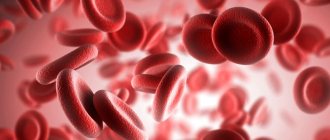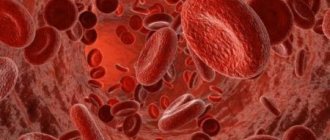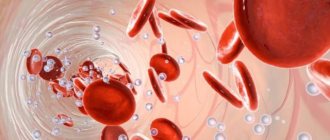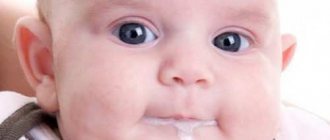A person lives for the sake of continuing life. On a subconscious level, everyone strives to leave behind heirs. And even though the “childfree” movement is gaining momentum, one day the moment comes when a woman or man happily takes into her arms the most important treasure - a child. From that time on, their life changes completely: their own desires fade into the background - the little king or princess takes up all their free time and thoughts, receiving only the best. Ideally, children should be happy, clean, well-fed and, of course, healthy. They constantly “please” their parents with something, and knocked-out knees are just the tip of the iceberg of childhood troubles. The health of children is the main task for loving parents. Any runny nose causes panic in the mother, and more serious diseases should be identified long before they develop. And if a child feels bad, he faints, is this due to simple fatigue or a serious pathology? Is it worth looking into this situation in more detail and immediately contacting doctors, or is fainting in children a common occurrence, a kind of stage in the growing up of a little person? Fainting, repeated more than once, should alert attentive parents, because this is a possible signal from the body about health problems.
Symptoms
Fainting is considered a protective reaction of the body, which protects the brain structures, temporarily removing them from work. He doesn't just appear. There is always a pre-fainting state.
Symptoms of fainting in a child are as follows:
- Severe dizziness appears.
- Clarity of mind is lost.
- There is a ringing in my ears.
- “Flies” and “stars” flash before my eyes.
- Legs lose stability.
- Intense sweating appears.
Fainting and metabolic disorders in the brain are thought to be related. This condition often occurs in schoolchildren. This is due to the fact that the pubertal period is still imperfect, when vascular tone is regulated.
About the clinical picture
The depth and duration of fainting in a child may vary. Usually it ranges from a few minutes to half an hour. This condition is likely to cause:
- Pale skin.
- Presence of cold, sticky sweat.
- Shallow breathing. Excursion movements of the chest are almost invisible.
- Weak pulse.
- Reduced peripheral blood pressure.
- Slow heart rate, which may give way to tachycardia.
This is how fainting manifests itself in a child 10 years of age or younger. There are usually several symptoms. In a horizontal position, a child's fainting passes faster. The reason for this is the redistribution of blood and intense flow to the brain. Often the condition recovers on its own, even if medical care is not provided.
Providing emergency care for fainting in children
The first and most important recommendation for parents if the baby has lost consciousness is not to panic and pull yourself together. It depends on how quickly you bring the child to his senses and how effective the help you provide him will be.
First aid for fainting in children:
- Immediately place the child in a horizontal position. The position of the legs should be slightly elevated in relation to the head in order to maximize blood flow to the brain;
- Provide oxygen access to the baby. If loss of consciousness occurs indoors, open the doors, allowing fresh air to ventilate. If there is a crowd of people in the room, ask them to leave or at least move away from the baby.
- If you faint, be sure to let your child smell ammonia; if you don’t have this drug on hand, lightly pat the child on the cheeks. This way you can bring him to his senses faster.
- When the condition has returned to normal, find an opportunity to give your baby something sweet - candy, a chocolate cube or a sweet drink. The child must remain horizontal until he fully regains consciousness or until the ambulance arrives.
Only a specialist can help determine the true reason why the loss of consciousness occurred. Moreover, this does not apply to the age of the baby and the reasons that led to this. Fainting in a child 3 years of age or older should definitely be a reason to visit a pediatrician and conduct a thorough examination.
Types of fainting
In 1995, E. N. Ostapenko made a classification of fainting conditions. In this regard, fainting in children can be of the following types:
- Vasodepressor. This type is often seen. It occurs from a stressful situation, often the condition appears during medical procedures, for example, injections.
- Orthostatic type of hypotension. This type is functional and appears when there is a lack of movement in the child’s daily cycle. But it can be associated with organic matter, the background of which may be diabetes, amyloidosis, or CNS neoplasms. The reason for the appearance of such conditions is associated with the insufficiency of vasopressor mechanisms.
- Reflex type fainting. It occurs as a response to procedures performed on reflexogenic zones. This applies to the throat, larynx, carotid sinus. Fainting in a child occurs when the vagus nerve is irritated.
- Fainting that is associated with a specific situation. It occurs when coughing, intense straining during bowel movements, or strong efforts to urinate. It also occurs when a heavy object is suddenly lifted. This is due to the fact that the pressure in the chest increases, and this complicates the outflow of blood from the brain.
- Fainting associated with hyperventilation syndrome. This condition appears during hysterical attacks. This condition leads to a state of hypocapnia, spasm of cerebral vessels.
External causes of fainting
Before considering the causes of an incomprehensible phenomenon, it is worth knowing that fainting is a loss of consciousness for a short period of time. Most people who experience syncope (the scientific name for this phenomenon) do not experience serious illness. Before fainting, tinnitus, severe weakness, darkness in the eyes, and “flying spots” appear. Adults suffer this phenomenon more severely.
In adolescents, syncope often occurs during puberty, and fainting in adolescents is associated with excessive physical activity, often characteristic of puberty. The causes of fainting in children are conventionally divided into external and internal. External factors include:
- Fatigue, overwork. The human brain is like a computer: due to severe overloads, it turns off. The baby’s brain is just beginning to develop, and an incorrect daily routine, an abundance of information, and physical activity do not give the main organ the opportunity to fully rest. The result is fainting, because this is a kind of protection of the brain from the abundance of information that a small organism is not able to process.
- Heatwave. Even adults faint from high temperatures in summer, but children are much more sensitive to the vagaries of nature.
- Lack of oxygen. Many feel panic, attacks of suffocation in dark small rooms, and the growing body of a child requires a lot of oxygen, fresh, clean air. Its deficiency leads to oxygen starvation - the brain “turns off”.
- Excess of emotions. It turns out that joy, especially excessive joy, can provoke loss of consciousness. In addition to “feelings of happiness,” syncope can be caused by feelings of intense fear or hatred. Young ladies in adolescence are especially susceptible to emotions.
- Hunger. If the brain does not receive nutrients, its activity drops sharply and fatigue sets in. If this phenomenon occurs constantly, then the most important organ simply refuses to work, because all the nutrients come to the baby with food. Therefore, parents whose child is malnourished need to be prepared for syncope.
- Bad dream. During sleep, the baby’s entire body rests; the brain is no exception to the rule. In order for an important organ to function correctly and normally, you need full, healthy sleep. An incorrect schedule, an uncomfortable bed, negative emotions, and fears make a child’s sleep interrupted and restless. The result is an irritable, unbalanced baby. If this situation repeats quite often, the brain itself switches off for a kind of reboot.
Parents should take into account all the factors why a child faints. Isolated cases indicate an unstable emotional background and negative influence. The baby experiences discomfort, and the brain, turning off, thus protects it.
External reasons
Why does a child faint? This condition has external causes. This condition may be associated with:
- Fluctuations in air temperature. The work of brain structures involves the release of energy potential. It is important that the energy component does not accumulate, but dissipates in space. As it increases, heat transfer decreases. There is no energy dissipation. At this time, the brain “overheats”, and then compensatory and protective mechanisms begin to work. The brain “turns off” for a while. New energy is not generated, and the accumulated energy is dissipated. When balance is achieved, the brain begins to function again.
- Reducing the presence of oxygen in the atmosphere. Brain activity occurs when there is sufficient oxygen supply. It cannot work under anaerobic conditions. Oxygen delivery is carried out by blood. Therefore, brain structures have their own blood circulation. In the lungs, the blood is saturated with oxygen, and it flows to the brain. With oxygen deficiency there will be less saturation of the blood. Neurocytes are considered sensitive to hypoxia and are unable to function normally under these conditions. This phenomenon occurs, for example, while climbing a mountain.
- High amounts of carbon monoxide in exhaled air. This condition appears when there is sufficient oxygen in the external air. Carbon monoxide has a pronounced tropism for hemoglobin, which is why carboxyhemoglobin appears. A sufficient amount of oxygen does not yet indicate that the blood is saturated with it. This is due to the fact that it cannot contact blood heme, since carbon dioxide is present instead. This occurs during carbon monoxide poisoning.
- Lack of nutrients. The child's menu should be rational and balanced. Children should not be allowed to go hungry for long periods of time. The diet can only be followed if prescribed by a doctor. The cellular structures of the brain only lack oxygen. They require nutritional components. Glucose is important because it is considered a source of energy. Without it, not a single process is carried out in the body. The body deposits it in different organs. At the right time, it is extracted and delivered to the required place. Therefore nutrition is important.
- An emotional outburst. Fainting in children is caused by emotions. This is often expressed in adolescents, especially girls. This is due to hormonal changes that are observed during the restructuring of the body.
- Fatigue. To prevent this, proper organization of the regime is required. Sleep is important because this is when the brain rests. Physiologically, sleep is recognized as saving the brain from overload.
Causes of fainting
Understanding why a child faints is not always easy without consulting a doctor. Most often, the mechanism for the occurrence of this condition is the inability of the cerebral cortex to function actively - this leads to loss of consciousness.
If a child faints, the reasons for this condition may be the following:
- Orthostatic collapse is a sharp decrease in blood pressure when changing body position. Typically, this situation occurs during active games or during awakening after sleep or abruptly getting out of bed.
- Hypoxia of the brain. Severe lung diseases, respiratory infections, and even being in stuffy rooms can cause a lack of oxygen in the nervous tissue of the brain, which leads to blackout.
- Arrhythmias are abnormal, irregular heart function. Pathologies leading to arrhythmia cause frequent fainting in a child, especially during physical exertion or emotional experiences.
- Head injuries. A fall and a blow to the head can not only lead to a concussion, but also cause intracranial hemorrhages, which pose a direct danger to the life of any person, including children.
- Brain infections. Inflammatory processes of the membranes of the brain and nervous tissue can also provoke fainting against a background of high fever, nausea and vomiting.
- Diabetic coma (hypoglycemic, ketoacidotic or hypoglycemic). If blood glucose levels are too high or low, it will lead to depression of consciousness to the point of coma, which primarily manifests as fainting.
- Coma due to poisoning or failure of internal organs.
- Tumors of the brain and spinal cord, as well as their membranes. In such diseases, the cause of fainting is increased pressure of the cerebrospinal fluid (spinal canal fluid) in the cranial cavity.
Various causes of fainting in children require a multifaceted approach to diagnosing this condition and identifying those diseases whose symptom in a child is loss of consciousness.
Internal reasons
If a child faints, there are also internal reasons:
- Anemia. This condition occurs when there is low hemoglobin in the blood. This protein is responsible for transporting oxygen to organs and tissues. When hemoglobin decreases, oxygen will reach the brain cells in small quantities. Neurocytes will be oxygen starved, which affects their work.
- Neoplasms of the brain. Tumors of brain tissue lead to disruption of brain function. In this case, there will be no normal transmission of nerve impulses. They will not go to the authorities and return. This leads to “overload” of the brain.
- Cardiac pathology. Disorders in the heart muscle lead to disruptions in the delivery of blood to the brain. This way he receives less oxygen.
- Conditions associated with autonomic dysfunction. The autonomic system is responsible for the activity of organs. If there is no pathology, these systems have a state of equilibrium. But during puberty, adolescents experience a hormonal surge, during which more hormones are released into the blood. The blood vessels of the brain also suffer.
- Diabetes. The disease itself does not lead to fainting. But if insulin is used incorrectly, a sharp decrease in sugar is likely, so the child faints. In severe cases, coma is likely to develop.
reasons for a child fainting
If a child of any age suddenly faints, there are certainly objective reasons for this.
As a rule, short-term loss of consciousness is provoked by the following factors:
- Iron-deficiency anemia. With this disease, the level of hemoglobin in the baby’s blood decreases significantly, and his body lacks not only iron, but also other useful microelements and vitamins. Since hemoglobin delivers oxygen to all internal organs and tissues, the baby’s brain cells are exposed to oxygen starvation, which can be very dangerous. To cope with this disease, children of any age need to eat properly and also take special iron-containing medications, for example, Maltofer;
- Prolonged fasting. The brain of young children is very sensitive to changes in blood glucose levels. When a child does not eat anything for a long time, the sugar level drops and can cause fainting;
- Diabetes mellitus and other endocrine diseases also cause various fluctuations in blood counts and in some cases can cause fainting and pre-fainting conditions in babies;
- The scream is too loud and prolonged. This reason often causes fainting in the youngest children. When a baby screams loudly for a long time and simply “beats” in hysterics, his nervous system becomes overexcited, which can cause loss of consciousness. Try not to bring your baby to this state under any circumstances;
- Severe fear can be caused by various reasons. For example, young children often faint in the treatment room at the sight of a health care worker, a syringe, or blood. If this situation repeats very often and makes parents worry about the health of their child, it is recommended to visit a child psychologist;
- In addition, any fainting, especially in a child in the first year of his life, may indicate pathologies of the cardiovascular system, for example, vegetative-vascular dystonia. Such diseases also lead to the fact that the child’s brain does not receive the amount of oxygen and other nutrients it needs, which is the direct cause of loss of consciousness;
- In school-age children, as well as in children who are overly busy, unexpected loss of consciousness can be associated with severe overwork, severe psycho-emotional experiences and lack of sleep;
- Finally, teenage girls may lose consciousness during the early stages of their menstrual cycle due to intense blood loss.
Other internal reasons
Fainting can also occur for the following reasons:
- Spasms of cerebral vessels. They are functional and organic, as well as congenital and acquired.
- Osteochondrosis in the cervical spine. With such suffering, the gait is straight. In a vertical view, the spine is under heavy loads, which is why destructive changes are observed in the cartilage tissue. When the cartilage thins, a hernia appears, compressing the vessels, disrupting blood flow. As a result, little blood flows to the cells, including the brain, and therefore brain function suffers.
The mechanism is simple
Article on the topic
Game for increase. Rules for hypotension All these cases share similar circumstances:
- fainting occurred on an empty stomach;
- the child stood for a long time on the verge of fainting;
- there was a lack of fresh air in a confined space;
- loss of consciousness occurred in the first half of the day.
The reason for the development of fainting is simple: blood, according to the law of universal gravitation, moves to the lower part of the body, and if the vasomotor center poorly controls vascular tone, the return of blood to the heart is reduced, therefore, less of it enters the vessels of the brain. And if the child has not eaten for a long time, there are few nutrients and oxygen in the blood, which means that the brain tissue is hungry, letting it know by fainting.
In teenage girls, menstruation (additional blood loss) is an aggravating factor. A child who has been in bed for several days (for example, with the flu) may faint when he first assumes an upright position.
Without feelings. What can cause fainting?
More details
Precursor to fainting
Before a child 7 years of age or older faints, some symptoms may include:
- The body feels weak. It's pronounced.
- The skin becomes pale and the child yawns.
- The limbs are cold to the touch.
- Mouth gets dry.
- There is a lack of air and increased breathing.
- Your ears will ring, and a bright veil will appear before your eyes.
A few seconds later the child falls. It is this condition that is fainting.
Diagnostics
To successfully combat this condition, as well as prevent it, it is necessary to establish the cause. Only then will treatment procedures become effective. Laboratory and instrumental studies are of great importance in diagnostic work and identifying causes. This primarily refers to blood tests.
- It is necessary to conduct a general clinical analysis, as well as an analysis to determine blood sugars.
- An electrocardiogram is required.
- To establish the reasons, you need to consult specialists. The child is sent for examination to a cardiologist, endocrinologist, or neurologist.
- Daily monitoring of heart function is carried out. If changes are detected, an ultrasound of the heart is performed.
- If a brain tumor is suspected, an MRI is performed.
- Anamnesis is collected. The doctor needs to get complete information about the child’s condition, so he asks different questions. Parents also provide useful information.
Detailed information during the history collection allows you to determine the general condition of the child. Only after diagnosis does the doctor prescribe treatment.
How to help?
Emergency care for fainting in children is carried out as follows:
- The child must be laid horizontally. The legs should be in an elevated position, so a cushion is placed under the knees. You can put your legs over the back of the sofa.
- It is necessary to free the neck and chest from constricting things. The buttons on the collar are unbuttoned to ensure free flow of air. You also need to open the windows and doors.
- Whiskey is rubbed with ammonia. You need to bring a swab to your nose, which is moistened with ammonia. You should not bring the entire bottle, as sudden movements of the head may cause the product to spill. Therefore, burns of the mucous membranes are likely.
- You need to apply an ice pack to your head. If it is not available, you need to pour water or place ice in a plastic bag.
Medical assistance for a child who faints is mandatory. Treatment is usually prescribed, and in complex cases hospitalization is required.
How does a child lose consciousness manifest, and how does he feel before it?
The main reason a child faints is a disruption of brain processes due to a sharp short-term outflow of blood. For a short time, the baby loses sensitivity and the ability to control his movements.
What does a child feel before he falls and what should parents pay attention to if the baby experiences frequent loss of consciousness? What should you pay attention to first? Alarming symptoms before an attack may include:
- Fainting in children begins with the manifestation of sudden weakness - the baby seems to sag, his skin turns pale;
- The child may complain of slight dizziness, loss of vision (“it gets dark in the eyes”);
- Before a child faints, he has a “ringing” in his ears, in his head, and unpleasant sensations in the form of nausea;
- The above symptoms are accompanied by an unstable pulse rhythm, it either quickens or becomes less frequent.
- If you are near your baby, you can observe how he suddenly begins to turn pale, beads of sweat appear on his forehead, then suddenly sinks to the ground and within 25-30 seconds stops responding to external irritating factors.
After the child fainted and then came to his senses, he still does not understand for some time what happened to him, being, as it were, in prostration. The rehabilitation stage begins, the baby may have a headache, feel nauseous and experience some pain in the chest, most often in the heart area. This condition may last for some time, and depends on the reasons why the baby lost consciousness, and on the help provided by parents or loved ones nearby.
Treatment
The main areas of treatment include getting rid of the causes that cause fainting:
- Proper organization of the daily routine is required in compliance with the main routine points.
- Proper nutrition is also necessary. Food should include vitamins and minerals. You should not allow monotony in your diet. Food should be varied in composition.
- For autonomic dysfunction, morning exercises are performed. A useful activity would be swimming in the pool.
- Baths with medicinal herbs that have a calming effect are effective. The use of lemon balm, chamomile, and bergamot is beneficial.
- If there are abnormalities on the ECG, you need drugs that nourish the heart muscle and vitamins.
- If fainting is associated with carbon monoxide, then a maximum supply of oxygen is required. In this case, inhalation of oxygen is used.
- If there are tumors in the nerve structures, treatment is prescribed by a neurologist.
It is advisable to discuss the treatment method with your doctor. It is important to follow all specialist recommendations. Only then will it be possible to get rid of this condition and also prevent complications.
Loss of consciousness in children
Maria
Hello, all the mothers who came to this page have probably encountered something similar and are now scrolling through the Internet with trembling hands in search of an answer.
I am the mother of a daughter who fell out of her crib at 9 months old, dad didn’t watch it, and after that it all started! I am now spending time sitting here, registering, etc., to reassure and warn many mothers from the mistakes that they can make due to the negligence and lack of education of many doctors! After this fall, we got what most parents who have more emotional children than everyone else, 1 - crying, 2 - FULL exhalation after which a spasm of the respiratory tract occurs, 3 - rolled eyes, 4 - facial spasm (not twitching, namely squeezes and holds for a few seconds), 5 - cyanosis (in some cases, some children have a white appearance), 6 - often the hands look like an arch or a hook at the bottom, 7 - loss of consciousness - the most dangerous in terms of injury (may fall and seriously hurt yourself on something ) and after all this, which in a normal case lasts from 20 to 60 seconds before the child leaves, the parents, in a semi-infarction state, almost die, get a full, sleepless night, and the fear of sending the child to kindergarten, grandmother, etc., and this is the beginning, then a bunch of doctors... And from this point in more detail!!!! We are one of those parents who were in the regional children's hospital, had an MRI, ECG, ECG, ultrasound through the fontanelle, encephalogram, and a bunch of other things! And this chapter is “shit” in my head, it says it’s EPILEPSY and I wrote a bunch of medications according to the usual list for epilepsy without even bothering, we are in shock, to put it mildly, tears in our eyes and semi-cardiac arrest! We're going to another doctor, then another one at 5!!! And over the course of these six months, these attacks occur even if the child does not want to leave the playground and, crying, gets another attack, and did not even receive candy or a doll, and then 4 attacks!!! (((and we, thank God saved us Because of a mistake, we did not take drugs for epilepsy, but would have made our child disabled for life with our own hands! I gave herbal sedatives 3 times a day, and only now, after 5 years, I realized what it was. This is - AFFECTIVE RESPIRATORY ATTACK Dear mothers, spend 30 minutes and do not maim your children, be calm and love your children, good health to all the little inhabitants of our planet!!! [Link removed]l It looks something like this: do not be confused if your face or hands are twitching or something else, it could be an epi attack, and timely contact with doctors and treatment is the key to success, I’m only talking about my case and an AFFECTIVE RESPIRATORY ATTACK And by the way, the encephalogram showed us in the occipital region the threshold for convulsive readiness was reduced, MRI - the brain is unchanged, and our child is very emotional and very active. And this lasted for us from 9 months to 1.5 years 5 times, from 1.5 to 3.5 often, then from 4 to 6 about 3-2-1 times a year! The main thing is that it has started to decline! And now there’s only a very strong pain after emotional stress, and also a sore throat and before that I fell in a heap and climbed into the car and hit my head hard, that’s what happened, and the most IMPORTANT thing, I almost forgot, the golden rule, don’t tap the child , believe me, this is stupid, I did it out of ignorance, it has not been tested effectively.!!((but WATER!!! YES WATER is your assistant, a cup of water on your head or face, don’t be afraid, then change into your T-shirt for the best , and it helps very quickly, and if you see that you have already started crying, then you immediately poured it into the bathtub under the tap or poured a bottle on your head and that’s it, sometimes you had to spit in your face, but what to do((!!! But remember one thing, it’s better to try to distract, and prevent an unplanned “washing” later)! And in kindergarten, warn them, otherwise the teacher will still have a heart attack. The most important thing is that children will not suffer from an attack if they do not fall and seriously hit themselves, that is, with consequences such as a broken head or knocked out teeth, and then new teeth will grow at 6!) so don’t be too nervous, because the health of the parents is not least important for the child, because it’s good that you are nearby and not in the hospital! It seems like everything!!) phew, I wrote it, my eyes are already on my forehead)! Peaceful dreams to everyone, and about cartoons, the main thing is that they are kind and calm, and do not strain the baby’s nervous system!!! I have 5 taboos for my daughter, these are: here and there, ninja go, ogi and cucaracha, and a couple more, track down what makes your child overexcited. Sorry for the mistakes, the phone itself changes the words((bye everyone! June 6, 2021 23:41
Prevention
If there are signs of fainting, you need to get rid of provocateurs. The child is laid down, the window is opened or taken out into the fresh air. Washing with cool water is helpful. When the reason lies in a hungry faint, then you need to eat something, preferably sweet. Juice or lemonade will do. Provoking factors must be avoided. Children need to get enough sleep and eat well.
Algorithm of actions
First aid for fainting:
- Place the child on a bench, sofa, moved chairs, on the floor so that the legs are higher than the head. This will increase blood flow to the brain;
- unfasten the tight collar, loosen the belt, belt;
Article on the topicHow to provide first aid if a person chokes or faints?
- open a window or window to increase the flow of fresh air;
- bring a cotton swab moistened with ammonia to the fainting person’s nose;
- splash cold water on his face;
- when he comes to his senses, give him hot sweet tea.
Many teenagers with vegetative-vascular dystonia are prone to fainting. Therefore, they should train their vasomotor center, teaching it to keep blood vessels in good shape. Morning exercises, contrast showers, daily walks in the fresh air in any weather, and good sleep will help with this. In the morning, before leaving home, you need to have breakfast.
If episodes of short-term loss of consciousness are repeated, it is necessary to examine the child in a hospital setting to exclude diseases of the nervous system and heart rhythm disturbances.











